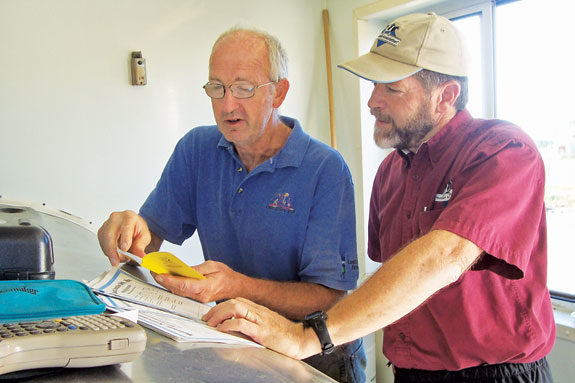Can paper be miraculous? Can paper get wet and not fall apart? Paper made by a Tacoma, Washington-based company with experience in the logging industry can. That company, Rite in the Rain, is now bringing its unique paper to the dairy industry. Judy Wolford was one of the first to purchase and use the new paper for her dairy. She found it after a friend told her to look for the special paper at World Dairy Expo in 2010.
“I hunted down the booth,” says Wolford. “They had a piece of paper in a bowl of water, and they pulled it out and said to write on it. And I did and thought, ‘This is really cool.’”
Wolford, who owns Silver Mist Farms in Ashville, Ohio, along with her husband, Dallas Rynd, took a brochure about the products. Wolford and Rynd milk 50 cows, including Holsteins, Ayrshires and Brown Swiss.
For Rynd’s birthday, Wolford gave her husband an 8½” x 11” notebook, which they use for dairy animal treatments, and a pocket-size dairy calving record book. Both were made from the paper that Wolford found at World Dairy Expo.
Jerry Darling, founder of J.L. Darling Corporation and the Rite in the Rain products, probably did not envision his paper being used as a record book for animal treatment. But he did envision a product that could withstand the elements in the Pacific Northwest logging industry during the 1920s.
“Rite in the Rain is an all-weather writing paper you can actually use outdoors,” says Rachel Johnson, Business Development at the J.L. Darling Corporation.

The paper is made to repel liquids of any kind, including sweat, rain, animal fluids and humidity. Liquid beads on the paper; it can even be written on underwater. Regular pencils and ball-point ink pens will write on the paper, and words that have been written on the paper will not smear when wet.
People who write outdoors are not limited to loggers, as the company soon found out. These products are not only being used by farmers, the military and for recreational use, but Hollywood has also seen the benefits of the products. They are used behind the scenes to help produce well-known television shows such as: “Deadliest Catch,” “Survivor” and “Dirty Jobs.”
All products are produced in the United States with only one byproduct – steam. The paper is made from renewable wood fiber chips. One of the main reasons the paper is so durable is because the wood chips do not come from recycled pulp.
These virgin fibers significantly improve the function of the end product. The wood fiber chips used are FSC-certified. The notebooks are also completely recyclable, just like regular paper.
The main difference, aside from the virgin fibers, is the patented coating. The paper goes through a machine that saturates it with the coating. The coating and its application process are trade secrets that give the paper its magical appeal.
The company has only been marketing its products to the ag industry for the past year, after farmers approached the company and suggested they create products for the industry.
While using the products, Wolford has seen what aspects of the calving record book that she likes and other parts she thinks could be modified.
“Three years from now I don’t care what the dam’s udder was like,” says Wolford. “I want to know who the sire was and how we identified the calf. I want a record book that is more geared toward the calf instead of the cow. It may work for a commercial herd, but at our house the calf is not 148 – it has a name.”
These products have crossed over into many different industries recently. The company called on producers, university officials and extension specialists to help them design the dairy record books. The template for the dairy calving record book contains columns for date, cow ID, calf ID, sex, calving ease, udder score, teat size and suspension and comments.
After seeing the exhibit and ordering some of the paper products, Wolford had this to say about her experience using the new technology.
“I am not one to walk around the booths,” Wolford says. “A lot of times they are neat ideas, but they may not work in an operation the size of ours or they are cost-prohibitive for us to use. This was a product that was absolutely useful, and it was priced right.”
The company’s pocket-sized notebooks can be used to document cow breeding, calving and animal treatment. These notebooks cost $5. Their regular paper size notebooks with blank pages cost $15. Their copier paper is available in packets of 200 sheets for $30. PD
For more information about the waterproof notebooks discussed in this article, go to riteintherain.com .
YOUR RESULTSWould you benefit from this type of paper?
The following checklist can be used to determine if this product might fit into your operation.
1. Do you document records by hand?
2. Do you document records while away from your office?
3. Do you need a way to record handwritten animal treatment, cow breeding or calving information?
4. Do you keep a handwritten notebook with important farm information?
5. Have you ever had records ruined because of water, manure or other fluids?
6. Does your record notebook need to stay outside for a long period of time?
7. Do you want to be able to recycle the paper from your record books? If you answered yes to three or more of these questions, then this technology may be a fit for you.
PHOTO:
TOP RIGHT: Dallas Rynd (left) and Holstein Association USA classifier Steve Neely look at calving dates in a Rite in the Rain notebook at Rynd’s dairy, Silver Mist Farms of Ashville, Ohio. Photo courtesy of Judy Wolford.





